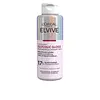Fenty Beauty We're Even Hydrating Longwear Concealer Versus L'Oreal Glycolic Gloss 5 Minute Treatment
What's inside
What's inside
 Key Ingredients
Key Ingredients

 Benefits
Benefits

 Concerns
Concerns

 Ingredients Side-by-side
Ingredients Side-by-side

Water
Skin ConditioningCaprylyl Methicone
Skin ConditioningDicaprylyl Carbonate
EmollientUndecane
EmollientPolyglyceryl-2 Dipolyhydroxystearate
Skin ConditioningGlycerin
HumectantPropanediol
SolventTridecane
PerfumingPolyglyceryl-6 Polyricinoleate
EmulsifyingSaccharomyces Ferment
Skin ConditioningAlbizia Julibrissin Bark Extract
MaskingShorea Robusta Resin
TonicSodium Chloride
MaskingPolyglyceryl-3 Diisostearate
Emulsifying1,2-Hexanediol
Skin ConditioningOpuntia Ficus-Indica Stem Extract
Skin ConditioningOctyldodecanol
EmollientStearalkonium Hectorite
Gel FormingDimethicone/Vinyl Dimethicone Crosspolymer
Skin ConditioningTriethoxysilylethyl Polydimethylsiloxyethyl Hexyl Dimethicone
Skin ConditioningDisteardimonium Hectorite
StabilisingPhenoxyethanol
PreservativeTocopheryl Acetate
AntioxidantPropylene Carbonate
SolventLauroyl Lysine
Skin ConditioningSodium Hyaluronate
HumectantSodium Benzoate
MaskingTocopherol
AntioxidantCitric Acid
BufferingSodium Citrate
BufferingIron Oxides
CI 77891
Cosmetic ColorantWater, Caprylyl Methicone, Dicaprylyl Carbonate, Undecane, Polyglyceryl-2 Dipolyhydroxystearate, Glycerin, Propanediol, Tridecane, Polyglyceryl-6 Polyricinoleate, Saccharomyces Ferment, Albizia Julibrissin Bark Extract, Shorea Robusta Resin, Sodium Chloride, Polyglyceryl-3 Diisostearate, 1,2-Hexanediol, Opuntia Ficus-Indica Stem Extract, Octyldodecanol, Stearalkonium Hectorite, Dimethicone/Vinyl Dimethicone Crosspolymer, Triethoxysilylethyl Polydimethylsiloxyethyl Hexyl Dimethicone, Disteardimonium Hectorite, Phenoxyethanol, Tocopheryl Acetate, Propylene Carbonate, Lauroyl Lysine, Sodium Hyaluronate, Sodium Benzoate, Tocopherol, Citric Acid, Sodium Citrate, Iron Oxides, CI 77891
Water
Skin ConditioningCetearyl Alcohol
EmollientCocamidopropyl Betaine
CleansingBehentrimonium Chloride
PreservativePropylene Glycol
HumectantAmodimethicone
CI 17200
Cosmetic ColorantCI 19140
Cosmetic ColorantCocos Nucifera Oil
MaskingSodium Chloride
MaskingHydroxypropyl Guar
Emulsion StabilisingHydroxycitronellal
PerfumingPhenoxyethanol
PreservativePPG-1 Trideceth-6
Skin ConditioningEthanolamine
BufferingTrideceth-6
EmulsifyingPolyquaternium-37
Limonene
PerfumingLinalool
PerfumingIsopropyl Alcohol
SolventPropylene Glycol Dicaprylate/Dicaprate
EmollientCaprylyl Glycol
EmollientAcrylates/Stearyl Methacrylate Copolymer
Emulsion StabilisingSorbitan Oleate
EmulsifyingCetrimonium Chloride
AntimicrobialCitric Acid
BufferingEDTA
Hexyl Cinnamal
PerfumingGlycolic Acid
BufferingParfum
MaskingWater, Cetearyl Alcohol, Cocamidopropyl Betaine, Behentrimonium Chloride, Propylene Glycol, Amodimethicone, CI 17200, CI 19140, Cocos Nucifera Oil, Sodium Chloride, Hydroxypropyl Guar, Hydroxycitronellal, Phenoxyethanol, PPG-1 Trideceth-6, Ethanolamine, Trideceth-6, Polyquaternium-37, Limonene, Linalool, Isopropyl Alcohol, Propylene Glycol Dicaprylate/Dicaprate, Caprylyl Glycol, Acrylates/Stearyl Methacrylate Copolymer, Sorbitan Oleate, Cetrimonium Chloride, Citric Acid, EDTA, Hexyl Cinnamal, Glycolic Acid, Parfum
 Reviews
Reviews

Ingredients Explained
These ingredients are found in both products.
Ingredients higher up in an ingredient list are typically present in a larger amount.
Citric Acid is an alpha hydroxy acid (AHA) naturally found in citrus fruits like oranges, lemons, and limes.
Like other AHAs, citric acid can exfoliate skin by breaking down the bonds that hold dead skin cells together. This helps reveal smoother and brighter skin underneath.
However, this exfoliating effect only happens at high concentrations (20%) which can be hard to find in cosmetic products.
Due to this, citric acid is usually included in small amounts as a pH adjuster. This helps keep products slightly more acidic and compatible with skin's natural pH.
In skincare formulas, citric acid can:
While it can provide some skin benefits, research shows lactic acid and glycolic acid are generally more effective and less irritating exfoliants.
Most citric acid used in skincare today is made by fermenting sugars (usually from molasses). This synthetic version is identical to the natural citrus form but easier to stabilize and use in formulations.
Read more about some other popular AHA's here:
Learn more about Citric AcidPhenoxyethanol is a preservative that has germicide, antimicrobial, and aromatic properties. Studies show that phenoxyethanol can prevent microbial growth. By itself, it has a scent that is similar to that of a rose.
It's often used in formulations along with Caprylyl Glycol to preserve the shelf life of products.
Chances are, you eat sodium chloride every day. Sodium Chloride is also known as table salt.
This ingredient has many purposes in skincare: thickener, emulsifier, and exfoliator.
You'll most likely find this ingredient in cleansers where it is used to create a gel-like texture. As an emulsifier, it also prevents ingredients from separating.
There is much debate on whether this ingredient is comedogenic. The short answer - comedogenic ratings don't tell the whole story. Learn more about comegodenic ratings here.
The concensus about this ingredient causing acne seems to be divided. Research is needed to understand if this ingredient does cause acne.
Scrubs may use salt as the primary exfoliating ingredient.
Learn more about Sodium ChlorideWater. It's the most common cosmetic ingredient of all. You'll usually see it at the top of ingredient lists, meaning that it makes up the largest part of the product.
So why is it so popular? Water most often acts as a solvent - this means that it helps dissolve other ingredients into the formulation.
You'll also recognize water as that liquid we all need to stay alive. If you see this, drink a glass of water. Stay hydrated!
Learn more about Water